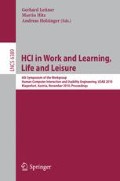Abstract
At work and at leisure people perform various visual search tasks, e.g. they search for a particular icon in software tools, on Web sites or on mobile phones. With an increasing number of items, visual search becomes difficult. Recently, it has been suggested that the so-called contextual cueing effect, which is known from psychological experiments, can be applied to improve visual search performance. Contextual cueing leads to decreased search times for target objects within familiar context configurations. It is assumed that associations between context configurations and target locations are learned implicitly and then used to guide the allocation of attention to the relevant object. In accordance with demands for interface consistency, this mechanism could be interesting for the development of user interfaces. The present study investigated which object features (e.g. color or orientation) can establish the learning process. The results show that implicit learning of color and orientation arrangements are possible, but the transfer to configuration with changed features depends on the recent learning history. Implications of these results are discussed with respect to the design of user interfaces.
Access this chapter
Tax calculation will be finalised at checkout
Purchases are for personal use only
Preview
Unable to display preview. Download preview PDF.
References
Treisman, A., Gormican, S.: Feature analysis in early vision: evidence from search asymmetries. Psychological Review 95, 15–48 (1988)
Bravo, M.J., Nakayama, K.: The role of attention in different visual-search tasks. Perception & Psychophysics 51, 465–472 (1992)
Yantis, S., Jonides, J.: Abrupt visual onsets and selective attention: Evidence from visual search. Journal of Experimental Psychology: Human Perception & Performance 10, 601–621 (1984)
Wang, Q., Cavanagh, P., Green, M.: Familiarity and pop-out in visual search. Perception & Psychophysics 56, 495–500 (1994)
Johnston, W.A., et al.: Attention capture by novel stimuli. Journal of Experimental Psychology: General 119, 397–411 (1990)
Krug, S.: Don’t Make Me Think! A Common Sense Approach to Web Usability. New Ryders, Indianapolis (2000)
Chun, M.M., Jiang, Y.H.: Top-down attentional guidance based on implicit learning of visual covariation. Psychological Science 10, 360–365 (1999)
Ozok, A.A., Salvendy, G.: Measuring consistency of Web page design and its effects on performance and satisfaction. Ergonomics 43(4), 443–460 (2000)
Holzinger, A., Stickel, C., Fassold, M., Ebner, M.: Seeing the System through the End Users Eyes: Shadow Expert Technique for Evaluating the Consistency of a Learning Management System. In: Holzinger, A., Miesenberger, K. (eds.) USAB 2009. LNCS, vol. 5889, pp. 178–192. Springer, Heidelberg (2009)
Schneider, W., Shiffrin, R.M.: Controlled and automatic human information processing: detection, search and attention. Psychological Review 84, 1–66 (1977)
AlTaboli, A., Abou-Zeid, R.: Effect of Physical Consistency of Web Interface Design on Users Performance and Satisfaction. In: Jacko, J.A. (ed.) HCI 2007. LNCS, vol. 4553, pp. 849–859. Springer, Heidelberg (2007)
Schankin, A., Stursberg, O., Schubö, A.: The role of implicit context information in guiding visual-spatial attention. In: Caputo, B., Vincze, M. (eds.) ICVW 2008. LNCS, vol. 5329, pp. 93–106. Springer, Heidelberg (2008)
Endo, N., Takeda, Y.: Selective learning of spatial configuration and object identity in visual search. Perception & Psychophysics 66(2), 293–302 (2004)
Song, J.-H., Jiang, Y.: Connecting the past with the present: How do humans match an incoming visual display with visual memory? Journal of Vision 5, 322–330 (2005)
Kunar, M.A., Flusberg, S., Horowitz, T.S., Wolfe, J.M.: Does Contextual cueing Guide the Deployment of Attention? Journal of Experimental Psychology: Human Perception and Performance 33(4), 816–828 (2007)
Schankin, A., Schubö, A.: Cognitive processes facilitated by contextual cueing. Evidence from event-related brain potentials. Psychophysiology 46, 668–679 (2009)
Godijn, R., Pratt, J.: Endogenous saccades are preceded by shifts of visual attention. Evidence from cross-saccadic priming effects 110(1), 83–102 (2002)
Stößel, C., Wiesbeck, M., Stork, S., Zäh, M.F., Schubö, A.: Towards Optimal Worker Assistance: Investigating Cognitive Processes in Manual Assembly. In: Proc. of the 41st CIRP Conference on Manufacturing Systems, pp. 245–250 (2008)
Findlay, J.M.: Saccade Target Selection During Visual Search. Vision Research 37(5), 617–631 (1997)
Findlay, J.M., Brown, V.: Eye scanning of multi-element displays: I. Scanpath planning, Vision Research 46, 179–195 (2006)
Howard, J.H., Howard, D.V., Dennis, N.A., Yankovich, H., Vaidyab, C.J.: Implicit Spatial Contextual Learning in Healthy Aging. Neuropsychology 18(1), 124–134 (2004)
Author information
Authors and Affiliations
Editor information
Editors and Affiliations
Rights and permissions
Copyright information
© 2010 Springer-Verlag Berlin Heidelberg
About this paper
Cite this paper
Stork, S., Voss, L., Schankin, A., Schubö, A. (2010). Context Information in Guiding Visual Search: The Role of Color and Orientation. In: Leitner, G., Hitz, M., Holzinger, A. (eds) HCI in Work and Learning, Life and Leisure. USAB 2010. Lecture Notes in Computer Science, vol 6389. Springer, Berlin, Heidelberg. https://doi.org/10.1007/978-3-642-16607-5_19
Download citation
DOI: https://doi.org/10.1007/978-3-642-16607-5_19
Publisher Name: Springer, Berlin, Heidelberg
Print ISBN: 978-3-642-16606-8
Online ISBN: 978-3-642-16607-5
eBook Packages: Computer ScienceComputer Science (R0)

